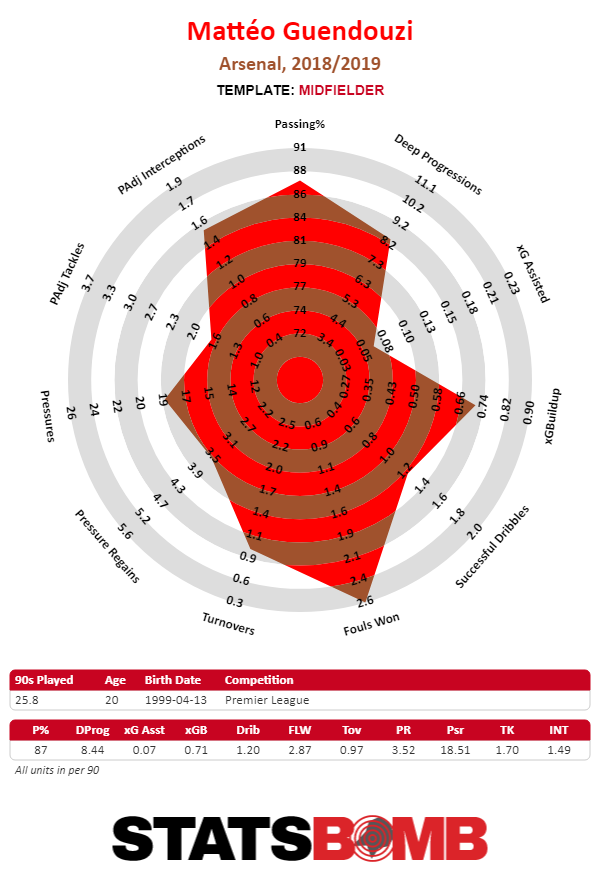Mattéo Guendouzi made the huge leap from Ligue 2 Lorient to Arsenal this time last year. Brought in under the influence of head scout Sven Mislintat for a fee of £7.2million, it was the type of addition (i.e. young, talented and on the cheap) that Arsenal fans had not seen enough of in recent seasons, with most of their previous signings having been on players who were entering their prime years at best. The absences of Granit Xhaka and the also-newly-arrived Lucas Torreira during a World Cup summer, gave the nineteen-year-old a full pre-season with the first team. This led to him being chosen as a starting midfielder against Manchester City on the opening day of the 2018/19 Premier League season. Over the course of the season Guendouzi showed real promise, especially considering his age, but also demonstrated areas of his game that desperately need improvement.
Control and awareness in possession
Guendouzi’s ability on the ball played a major role in his development at Arsenal. At the beginning of the season, Emery positioned him as one of the two deep midfielders in a 4-2-3-1, where he was constantly tasked with receiving short from the goalkeeper and centre-backs in the buildup phase. It was fairly clear in these opening two matches that there were some parts of this job that he struggled with. Against City, Guendouzi was forced to play on the right side of the double pivot. which took him out of his comfort zone and stopped him from having as great an effect on ball progression. That mostly comes down to his awareness, or lack thereof. Whilst the deep midfielder does scan the area around him, he does it sporadically. Noticeably, he doesn’t do it at all when he’s about to receive a pass, which makes finding the next option all the more difficult. Particularly for a right-footer on the right side of the pitch, he can’t open his body up quite as well as he can on the left to compensate.. That’s one reason why he and Xhaka don’t necessarily make for a great pairing, and why he’s a much more effective option when he can play on the left side of midfield in a partnership with Torreira. When he plays on the left side, the difference is massive. What he, as one of the deep midfielders, was frequently instructed to do was drop to the sides of the centre-backs, thus allowing the full-backs to push on and become greater wide threats. This suited him perfectly. Dropping away from the pressure of the opposition’s block and into a position where his angle sets him up to see everything he needs to see as soon as he receives it, afforded him much more time and space. Even when he was pressured in that position, his shielding of the ball proved to be one of his stronger assets – although it was something he didn’t use enough as a way of evading pressure in the first half of the season, in general. What shouldn’t be missed when discussing his impact in both these positions is his positivity with the ball. He will always find a way to open his body up, so he can have the option to play forward. Whilst the cushion, weaker-foot touch wasn’t as prominent right at the beginning of the season, he was more comfortable using it in every instance by the end of the season. 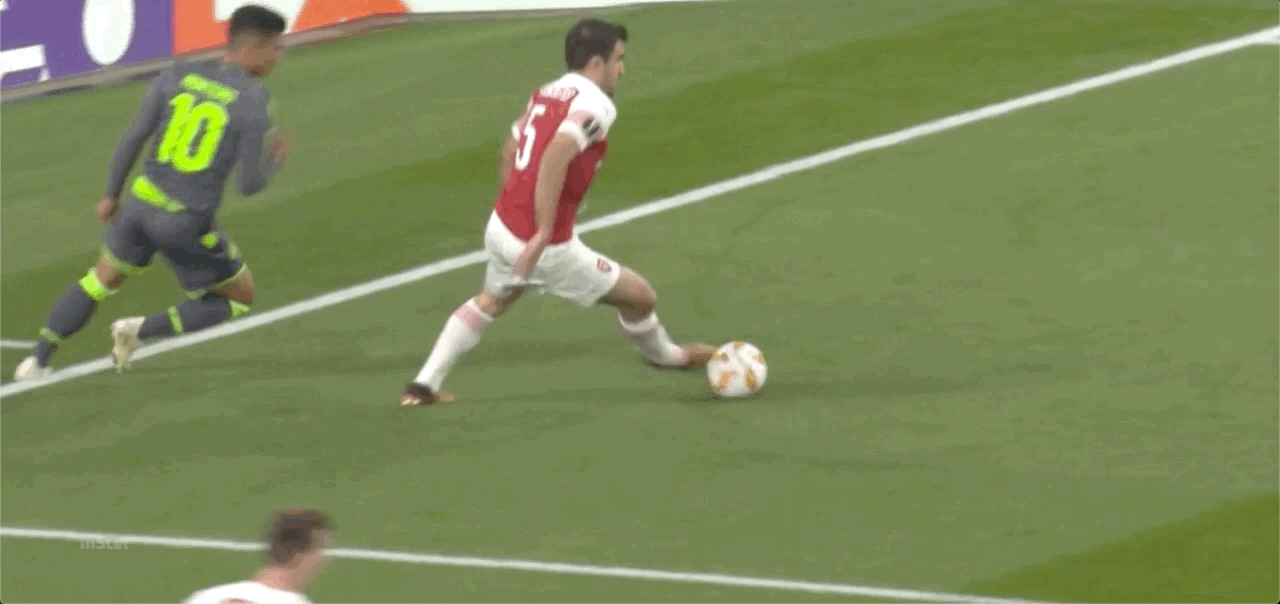 On the right, he would be caught receiving with his back-to-goal rather than on the half-turn, as can be seen in the example above. Add to that his lack of pre-emptive scanning and it made for nightmare scenarios when receiving with his back-to-goal out from the back. Because of this, he could only hope to win fouls, since he had no idea if there was the possibility of a ball around the corner of his opponent to break the press. Another aspect of his game which developed over the course of the season was driving forward with the ball. Similarly to the way he used shielding well but not frequently enough, Guendouzi seemed reluctant to carry the ball further than a few yards. This, however, improved drastically towards the end of the season, to the point where he would openly drive through the centre of the pitch, towards the final third, looking to combine with other attackers. This was indeed helped by the more consistent use of a 3-4-3 system towards the back-end of the season. What also consistently improved throughout the season was his awareness of space when not receiving the ball. The Frenchman can be best described as a high-energy midfielder. When given the freedom, he can be everywhere at once, especially in possession. He will switch the ball to one side and sprint across to support on that far-side. And, what’s most impressive about this is that his vigorous movement is never at the cost of his team. He doesn’t overcrowd spaces by doing this, he usually ends up filling big holes that were previously vacated. His contributions higher up in the 3-4-3, were quite beneficial in providing attacking links and overloads. Ultimately, this raises the question: could he be a dependable number six?The answer to that question depends on his positional discipline. Despite his willingness to move around the pitch, his development as a player might depend on being constrained to the first and second phases of buildup play. Here’s why.
On the right, he would be caught receiving with his back-to-goal rather than on the half-turn, as can be seen in the example above. Add to that his lack of pre-emptive scanning and it made for nightmare scenarios when receiving with his back-to-goal out from the back. Because of this, he could only hope to win fouls, since he had no idea if there was the possibility of a ball around the corner of his opponent to break the press. Another aspect of his game which developed over the course of the season was driving forward with the ball. Similarly to the way he used shielding well but not frequently enough, Guendouzi seemed reluctant to carry the ball further than a few yards. This, however, improved drastically towards the end of the season, to the point where he would openly drive through the centre of the pitch, towards the final third, looking to combine with other attackers. This was indeed helped by the more consistent use of a 3-4-3 system towards the back-end of the season. What also consistently improved throughout the season was his awareness of space when not receiving the ball. The Frenchman can be best described as a high-energy midfielder. When given the freedom, he can be everywhere at once, especially in possession. He will switch the ball to one side and sprint across to support on that far-side. And, what’s most impressive about this is that his vigorous movement is never at the cost of his team. He doesn’t overcrowd spaces by doing this, he usually ends up filling big holes that were previously vacated. His contributions higher up in the 3-4-3, were quite beneficial in providing attacking links and overloads. Ultimately, this raises the question: could he be a dependable number six?The answer to that question depends on his positional discipline. Despite his willingness to move around the pitch, his development as a player might depend on being constrained to the first and second phases of buildup play. Here’s why.
Speed, vision, range and execution
What has most impressed me about Guendouzi is not only his spectacular passing range but also all that comes with it. What he lacks in pre-emptive awareness he makes up for in his operation speed (i.e. how quickly he can recognise a situation and act on it). Even though his receiving techniques don’t afford him too much time, his speed of thought once he’s turned and got his head up is outstandingly quick. All he needs is a split second and to identify a line-splitting pass or a run to play in over the top. Both of these types of passes he is a specialist at playing. It was hard to keep count of just how many times this season he delivered a perfectly-placed, drilled ball through the midfield to one of the attackers between the lines. These kinds of passes saw him form a brief-but-pleasing partnership with Mesut Özil. And, even the passing example below didn’t quite come off for him, it also depicts the ambitiousness in his range and the risks he’s more than willing to take. 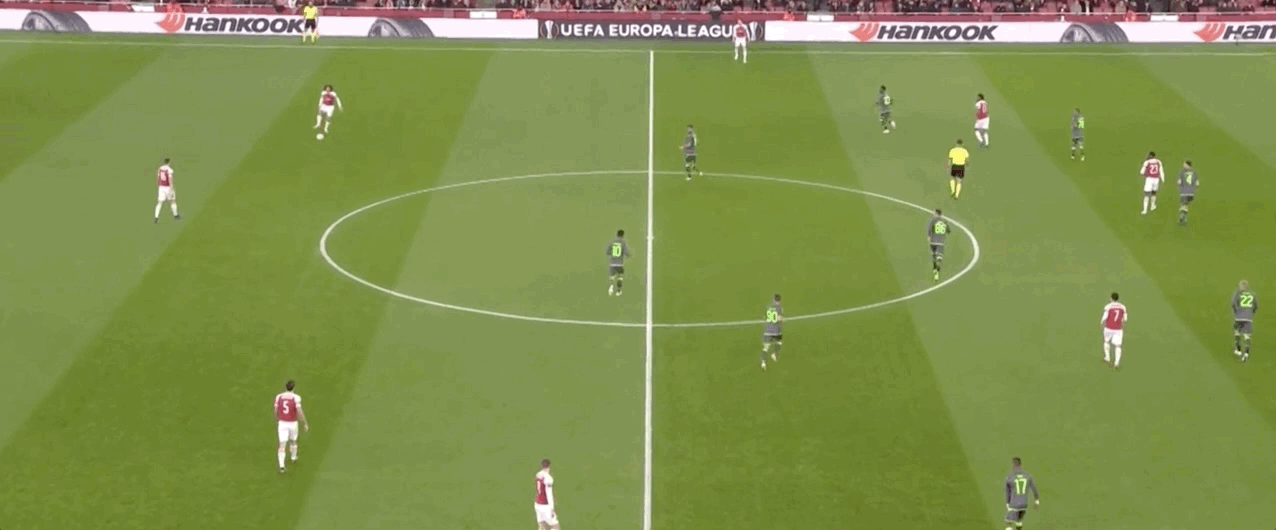 What is also hugely important in pulling off this type of pass is ensuring it’s not predictable. Thankfully, the speed at which he releases the ball gives opposition defenders little time to read the pass and shift. Equally, he has frequently used pauses on the ball and big open stances, as if he was about to ship it long, in order to disguise his next action. His longer, aerial passes are also always so perfectly placed – landing on his teammate’s feet almost without fail. His technique tends to involve the slightest bit of backspin that allows him to exploit even the smallest of gaps behind the last line.
What is also hugely important in pulling off this type of pass is ensuring it’s not predictable. Thankfully, the speed at which he releases the ball gives opposition defenders little time to read the pass and shift. Equally, he has frequently used pauses on the ball and big open stances, as if he was about to ship it long, in order to disguise his next action. His longer, aerial passes are also always so perfectly placed – landing on his teammate’s feet almost without fail. His technique tends to involve the slightest bit of backspin that allows him to exploit even the smallest of gaps behind the last line. 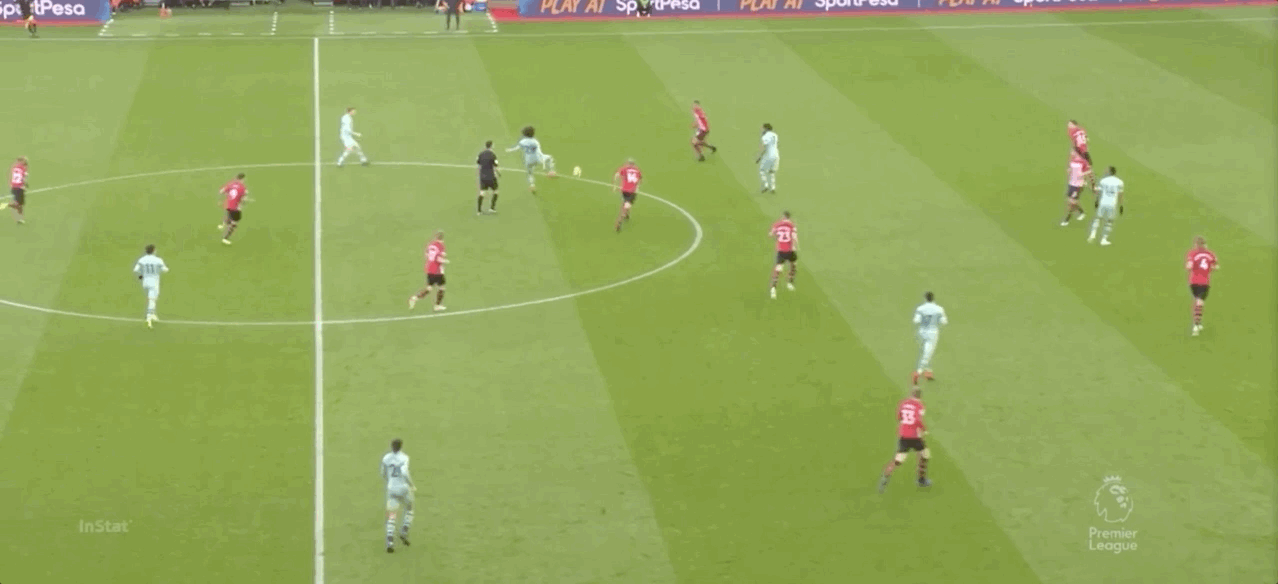 Of course, with such a broad range, there is usually a big drawback, like decision-making – something his teammate, Xhaka, suffers from. But that seems far from the case. Only on rare occasions, where his lack of pre-emptive scanning has stopped him from assessing both sides properly, has he taken up the wrong option. His intelligence in knowing which pass to play is another big plus point. The numbers support this as well. Only Xhaka and Ozil progressed the ball more frequently from deep positions than Guendouzi did.
Of course, with such a broad range, there is usually a big drawback, like decision-making – something his teammate, Xhaka, suffers from. But that seems far from the case. Only on rare occasions, where his lack of pre-emptive scanning has stopped him from assessing both sides properly, has he taken up the wrong option. His intelligence in knowing which pass to play is another big plus point. The numbers support this as well. Only Xhaka and Ozil progressed the ball more frequently from deep positions than Guendouzi did. 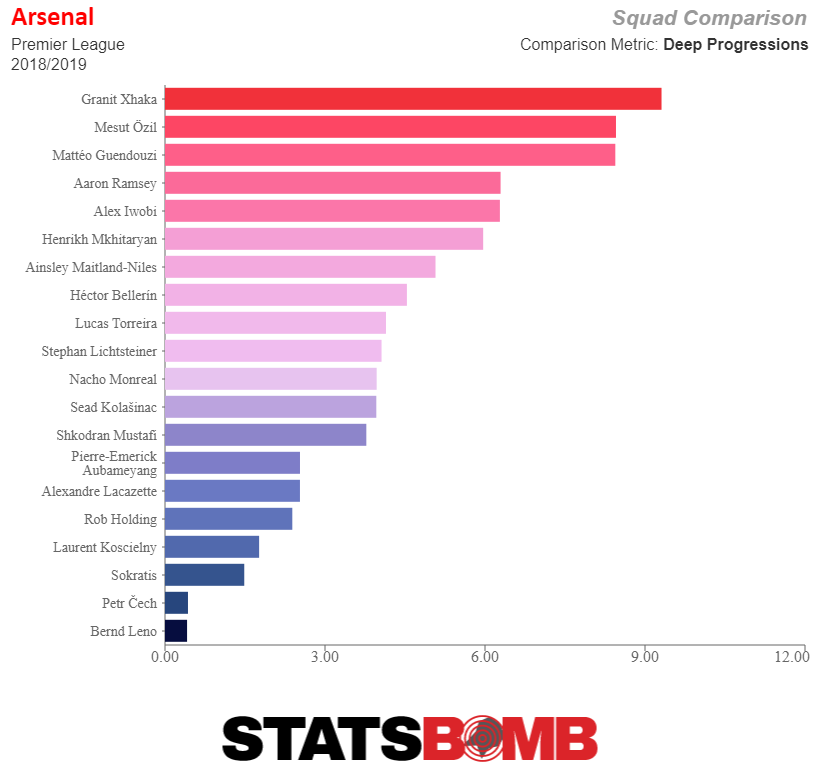 And as for pass selection, while Xhaka is a long ball distribution machine, completing almost twice as many as Guendouzi, 8.40 to 4.38 per 90 minutes, it’s Guendouzi who is the more efficient of the two. His completion rate on long balls last season was 73% while Xhaka’s was 61%. Anytime Xhaka had time and space he’d opt to hit it long, delivering 12.23 unpressured longball attempts per match, while Guendouzi only selected to play it long 5.38 times while not under pressure. Those numbers might be influenced by their tactical roles, but even so it’s clear that Guendouzi’s inclination is to play incisive balls upfield when the opportunity is there while Xhaka is more aggressively trying to create opportunities even when they are less apparent.
And as for pass selection, while Xhaka is a long ball distribution machine, completing almost twice as many as Guendouzi, 8.40 to 4.38 per 90 minutes, it’s Guendouzi who is the more efficient of the two. His completion rate on long balls last season was 73% while Xhaka’s was 61%. Anytime Xhaka had time and space he’d opt to hit it long, delivering 12.23 unpressured longball attempts per match, while Guendouzi only selected to play it long 5.38 times while not under pressure. Those numbers might be influenced by their tactical roles, but even so it’s clear that Guendouzi’s inclination is to play incisive balls upfield when the opportunity is there while Xhaka is more aggressively trying to create opportunities even when they are less apparent.
Defensive awareness, tackling and jockeying
Unfortunately, defending is probably the pitfall of Guendouzi. The infrequency at which he scans the pitch, and his subsequent awareness, is at its worst during defensive phases. His non-existent scanning leads to all sorts of trouble when defending in any capacity. Instead of being aware of his surroundings, he is overly aware of where the ball is and only the opponents he can easily spot in his periphery. As a result, he – throughout the whole of the season, not just at the start – was guilty of blocking one way into an obvious option whilst leaving the forward space completely open. This was particularly the case when an attacker was dribbling in from the flanks. 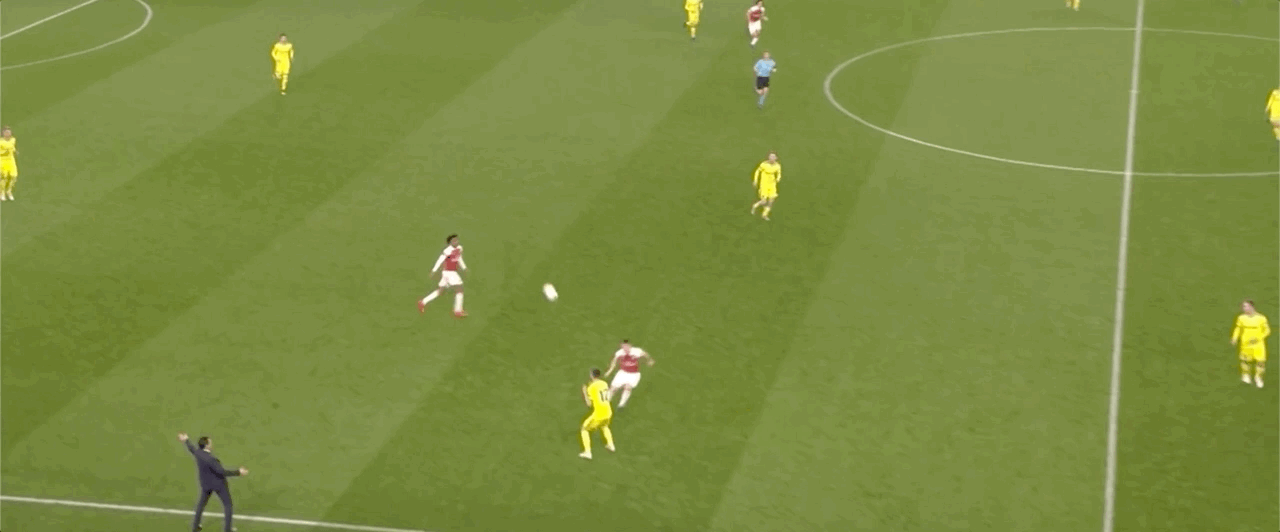 In addition to this, there was also the problem of his jockeying stance. Most often exposed when pressing high up the pitch in pursuit of the ball, Guendouzi would be far too heavy-footed, making it difficult for him to adjust when a ball passed him by. To make matters worse was that fact that he didn’t know when to step off in pursuit of the ball. In the same cases where he was vulnerable to dribbles inside, he was also susceptible to passes into players he was supposed to be closing down. In these situations, he rushed to get in front to intercept but, realistically, was never going to make it there in time, which just allowed his opponent to let the ball come across him before pushing it on past him.
In addition to this, there was also the problem of his jockeying stance. Most often exposed when pressing high up the pitch in pursuit of the ball, Guendouzi would be far too heavy-footed, making it difficult for him to adjust when a ball passed him by. To make matters worse was that fact that he didn’t know when to step off in pursuit of the ball. In the same cases where he was vulnerable to dribbles inside, he was also susceptible to passes into players he was supposed to be closing down. In these situations, he rushed to get in front to intercept but, realistically, was never going to make it there in time, which just allowed his opponent to let the ball come across him before pushing it on past him. 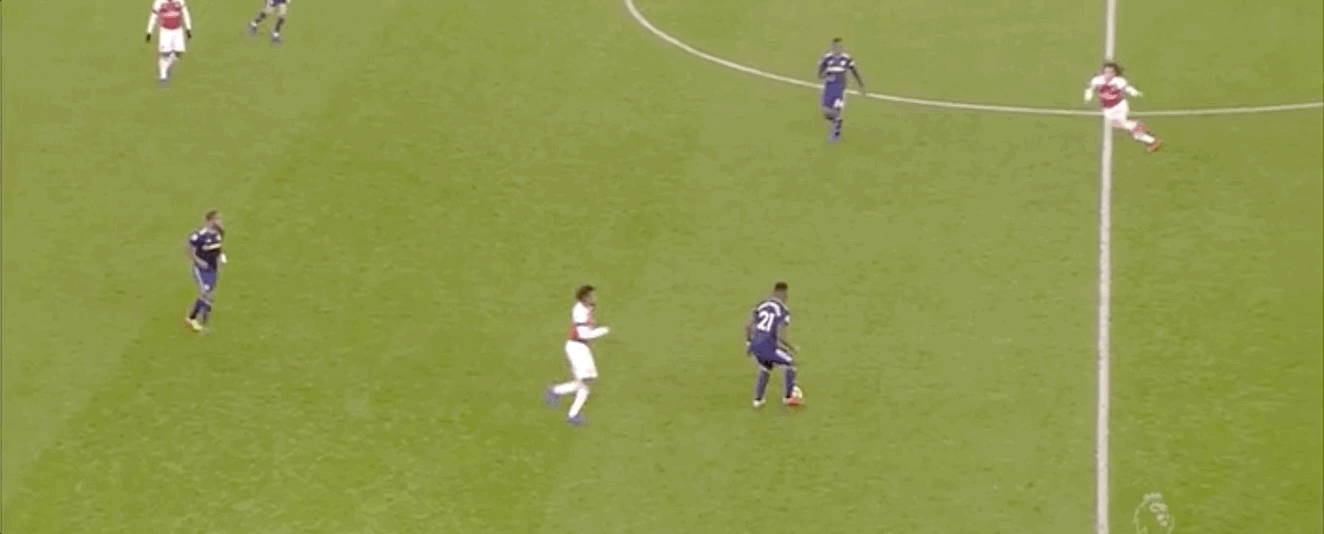 When he is beaten, he’s often very slow to recover, as well. He doesn’t bust a gut to get back to the box, nor is he ever prepared for the possibility of give-and-go exchanges. In front of the box is also another place where his jockey stance can be easily exposed. He doesn’t keep low enough to the ground, but will instead form a rigid-like statue of a stance, which prevents him from dealing with attackers’ turns back against the grain of his press, as could be seen in the very first goal Arsenal conceded this season. He is also easily manipulable when defending zonally, as he doesn’t spot movements behind him, so can be easily drawn out of position by short exchanges between players in front of and behind him as he looks to chase down the ball. On top of this, he rarely seems prepared to hunt the ball back towards his own goal. He never sets himself in a way that allows him to keep up with give-and-go exchanges which he is sometimes a victim to. Just about the only redeemable aspect of his defending is his tackling. Guendouzi’s tackling approach involves nipping away at opposition players, using his long legs to do so, whilst he uses his body strength to help separate the ball from the man. This saw him run up an average of 1.7 possession adjusted tackles per ninety minutes, which is not too bad,, but still less than the rest of Arsenal’s midfielders. Xhaka, Torreira and Ramsey had 2.84, 2.56 and 2.33 respectively.
When he is beaten, he’s often very slow to recover, as well. He doesn’t bust a gut to get back to the box, nor is he ever prepared for the possibility of give-and-go exchanges. In front of the box is also another place where his jockey stance can be easily exposed. He doesn’t keep low enough to the ground, but will instead form a rigid-like statue of a stance, which prevents him from dealing with attackers’ turns back against the grain of his press, as could be seen in the very first goal Arsenal conceded this season. He is also easily manipulable when defending zonally, as he doesn’t spot movements behind him, so can be easily drawn out of position by short exchanges between players in front of and behind him as he looks to chase down the ball. On top of this, he rarely seems prepared to hunt the ball back towards his own goal. He never sets himself in a way that allows him to keep up with give-and-go exchanges which he is sometimes a victim to. Just about the only redeemable aspect of his defending is his tackling. Guendouzi’s tackling approach involves nipping away at opposition players, using his long legs to do so, whilst he uses his body strength to help separate the ball from the man. This saw him run up an average of 1.7 possession adjusted tackles per ninety minutes, which is not too bad,, but still less than the rest of Arsenal’s midfielders. Xhaka, Torreira and Ramsey had 2.84, 2.56 and 2.33 respectively.
What’s next?
Guendouzi still has a long way to go if he wants to become the complete package. However, even as a very-much-unpolished product, he is still worth gambling on and given his age it’s reasonable to expect even more from him next season. His stats so far suggest he can become the focal point of progression from the deepest phases. If Emery wants to get the best out of him, though, it seems like the quickest way to do so is to continue playing him off the left of a double pivot in a 4-2-3-1 next to Torreira, with the Uruguayan midfielder acting as the necessary balancer for all of Guendouzi’s defensive issues.
